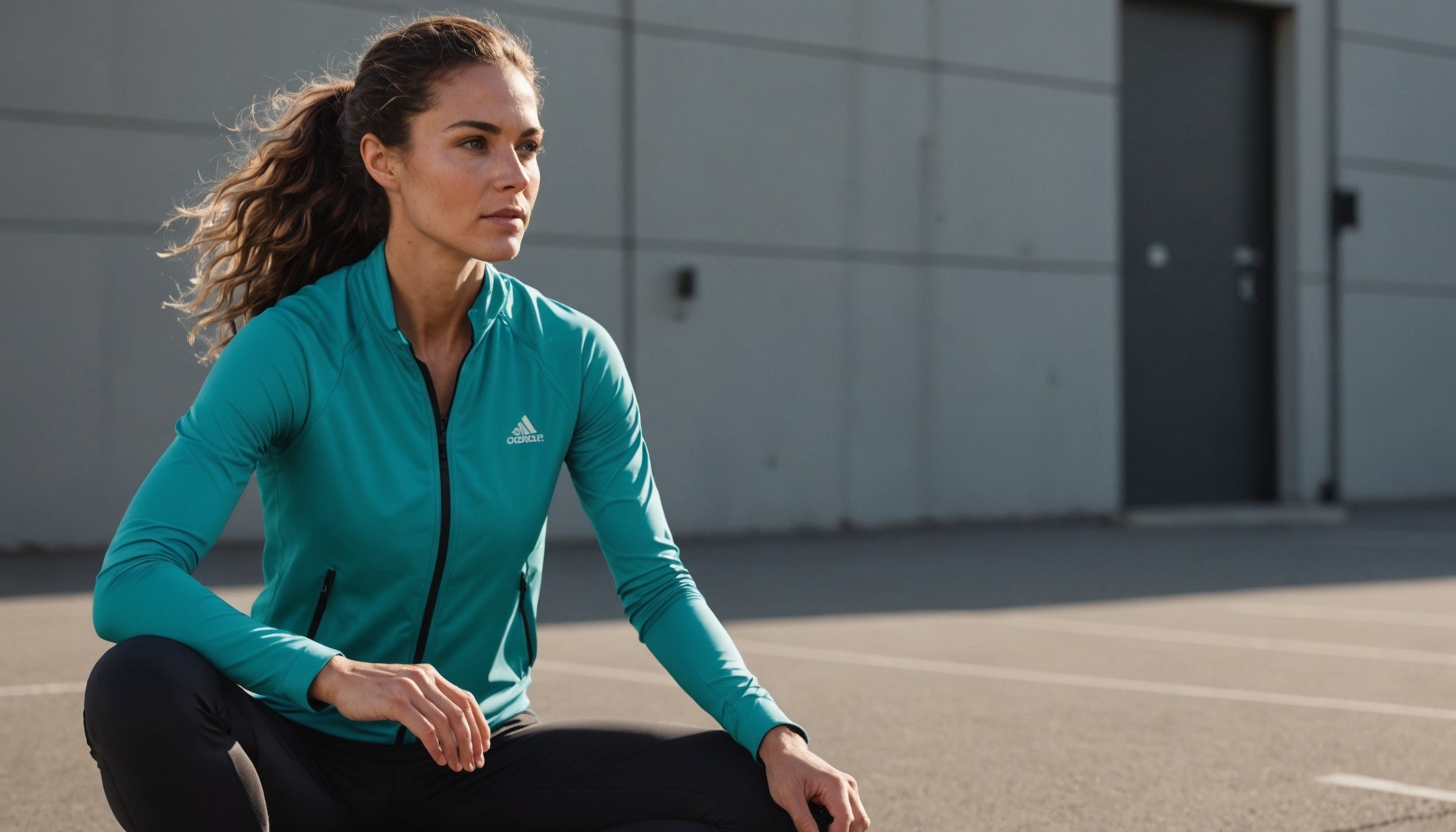Overview of Resilient Fabrics in Activewear
The role of resilient fabrics in women’s activewear is crucial for performance and durability. Fabric choice significantly affects how garments withstand wear and tear, maintain comfort, and meet athletes’ demands. Historically, activewear materials have evolved from basic natural fibers to sophisticated ones, crafted to enhance performance and longevity.
In earlier decades, materials like cotton were popular in activewear. However, they lacked the moisture-wicking and stretch properties needed for high-performance activities. As technology advanced, a shift towards modern resilient fabrics emerged, rendering them indispensable in today’s sportswear landscape.
Topic to read : Mastering small closet storage: expert tips for efficient space optimization
Resilient fabrics integrate innovative weaving techniques and synthetic fibers. This revolution allows them to withstand the rigors of physical activity while providing comfort and flexibility. These modern materials are engineered to enhance both athletic performance and garment lifespan.
Today, fabric technology has pushed boundaries, introducing materials that are not only resistant to wear but also cater to sustainability needs. New resilient fabrics emphasize recyclability and reduced environmental impact, signaling a positive trend in the activewear industry.
Also to discover : Spring into style: your essential guide to the best eco-friendly bags for sustainable fashion
Overall, the evolution of textile engineering showcases how innovative materials have become mainstream, driving the activewear industry forward with practical, durable solutions.
Key Types of Resilient Fabrics
As consumers become more discerning in their activewear choices, understanding the types of activewear fabrics available becomes imperative. Each fabric type comes with unique properties influencing performance and fabric durability.
Polyester
Polyester is a staple in activewear due to its durability and moisture-wicking characteristics. Its hydrophobic nature ensures sweat is drawn away from the body, which is ideal for intense activities. On the downside, polyester can sometimes retain odours and may not be the most breathable option.
Nylon
Another popular option is nylon, renowned for its elasticity and smooth texture. It offers a luxurious feel while maintaining toughness against abrasions and tears. The elasticity supports significant movement, making it a favourite for athletes. However, nylon may not regulate moisture as effectively as other fabrics.
Spandex
Lastly, spandex is celebrated for its exceptional stretchability. This fabric conforms to the body, allowing unrestricted movement, crucial for form-fitting garments like leggings and sports bras. While spandex offers incredible flexibility, it might blend with other materials to enhance its breathability and strength.
Understanding these fabrics’ individual strengths and performance characteristics helps in selecting materials that cater specifically to activewear needs.
Benefits and Drawbacks of Different Fabrics
The choice of materials in women’s activewear plays a critical role in balancing the benefits and drawbacks of various fabrics. Understanding these aspects can help consumers make informed decisions.
Each fabric type offers distinct strength and flexibility. For example, polyester is renowned for its durability and moisture-wicking capabilities, ensuring it withstands vigorous activities. Nylon, on the other hand, provides a smooth texture and elasticity, supporting substantial movement. Spandex excels in flexibility, conforming snugly to the body for optimal comfort.
However, these benefits are often weighed against certain disadvantages. For instance, polyester, while durable, can retain odors and might not be as breathable. Nylon’s elasticity is a boon, yet it may falter in moisture regulation compared to polyester. Spandex, though flexible, often requires blending with other materials to improve breathability and strength.
Alongside performance considerations, the environmental impact of fabric choices is becoming a significant concern. Consumers are increasingly seeking sustainable options like recycled polyester or eco-friendly nylon, which aim to mitigate ecological damage. This shift highlights an industry trend towards environmental consciousness, pushing fabric development towards more sustainable solutions. Understanding these factors is crucial for choosing fabrics that align with both performance needs and sustainability goals.
Innovations in Fabric Technology
The recent advancements in fabric technology have profoundly influenced innovative materials used in activewear, focusing on creating more sustainable fabrics. These breakthroughs aim to enhance the functional aspects of activewear while addressing the growing demand for environmentally friendly products.
One notable development is the introduction of biodegradable synthetic fibers. These materials maintain performance capabilities like durability and elasticity but break down more easily in landfills, reducing environmental impact. Additionally, the use of recycled fibers has gained traction. By repurposing plastic bottles and other waste materials, manufacturers produce resilient fabrics that offer similar qualities to virgin fibers, offering a dual benefit of performance and eco-consciousness.
Innovation doesn’t stop at fibers. Fabric technology now encompasses coatings that resist water, stains, and UV rays, extending the life of activewear. These advances enable garments like sports bras, leggings, and outerwear to better withstand diverse conditions, offering athletes superior protection and comfort.
Emerging materials, such as graphene-infused fabrics, present promising futures. Graphene’s thermal management qualities promise advanced temperature regulation, enhancing comfort in various climates. Such innovations depict how technology continues to redefine fabric performance, making strides toward functional, sustainable solutions.
Practical Applications of Resilient Fabrics
Incorporating resilient fabrics into activewear applications hinges on selecting the right materials for specific gear. Understanding fabric usage in garments like sports bras, leggings, and outerwear is crucial for optimal performance and comfort.
Sports bras
Sports bras demand a blend of elasticity and support. Fabrics such as spandex are ideal due to their excellent stretchability, offering compression and support without hindrance. Combining spandex with materials like polyester enhances moisture management, ensuring wearers remain comfortable during workouts.
Leggings
For leggings, the choice of fabric focuses on stretch and form retention. Fabrics like nylon or a nylon-spandex blend provide a combination of durability and flexibility. These materials adapt to movement while maintaining their shape, crucial for high-stretch garments.
Outerwear
Outerwear like jackets and vests benefits from materials providing breathability and environmental protection. Polyester is often favored for its moisture-wicking and wind-resistant properties. Additionally, newer fabric technologies incorporate water-repellent treatments, enhancing wearability in diverse weather conditions.
By aligning fabric choices with the specific needs of each garment category, manufacturers can ensure that resilient fabrics deliver the right balance of comfort and performance. This targeted approach highlights how technical advancements in fabric technology influence design in women’s activewear.
Expert Insights and Recommendations
In the realm of activewear, the guidance of textile experts and seasoned designers can deeply influence fabric choices. Their knowledge not only sheds light on the intricacies of resilient fabrics but also aids consumers in selecting materials that stand the test of time and performance.
Interviews with experts reveal that fabric choice is paramount. They emphasize selecting materials like nylon and spandex for their balanced flexibility and durability. These fabrics are highlighted for their ability to maintain shape and withstand rigorous movement, making them ideal for athletic pursuits.
Insights also underscore the importance of aligning fabric properties with activity demands. Moisture-wicking polyester is often recommended for high-intensity workouts due to its breathability.
Consumers are advised to consider eco-friendly fabric options as well. Fabrics using recycled fibers offer a sustainable alternative without compromising performance, aligning with growing environmental consciousness in the industry.
User testimonials further back these expert opinions, noting the remarkable resilience and comfort these fabrics provide. This advice assists in making informed decisions that enhance both the functionality and sustainability of women’s activewear.
Visual Comparisons and Case Studies
Visual presentations offer an insightful look into the world of fabric technology, particularly in women’s activewear. By comparing fabric durability through visuals, consumers can better grasp how different materials perform under various conditions.
Durability Tests
Infographics often display results from rigorous durability tests, comparing resilient fabrics like polyester, nylon, and spandex. These visuals highlight each fabric’s resistance to wear, emphasizing polyester’s durability despite holding odours and nylon’s flexibility coupled with possible moisture regulation challenges.
Side-by-Side Comparisons
Fabric comparisons can visually depict differences in stretch, moisture-wicking abilities, and environmental impact. Such side-by-side analysis assists consumers in making informed choices tailored to their activity levels and personal preferences.
Case Studies in Activewear
Real-life case studies shed light on successful fabric usage in garments. For instance, using nylon blends in high-movement areas of leggings demonstrates enhanced flexibility and durability. Similarly, spandex, when used effectively, brings unmatched stretchability to sports bras, ensuring comfort and performance.
These visual tools not only enrich consumer understanding but also underline the necessity of aligning fabric characteristics with individual needs and environmental considerations.











